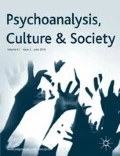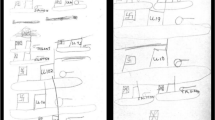Abstract
This paper traces a canon of documentary filmmakers in post-war psychoanalysis that informed the nascent field of child development. In examining the context for this visual turn, it analyses James Robertson’s A Two-Year-Old Goes to Hospital (Robertsonfilms and Concordmedia, Suffolk, 1952), which tracks the devastating emotional decline of a young girl separated from her primary carers for eight days. The paper foregrounds the aesthetic dimension inherent in the film’s production, which has been significantly under-investigated. It explores how this figuration of object relations theory contributed to the popularisation of a new discourse in infant subjectivity, namely attachment theory. Understanding is advanced by explicating how documentary film may produce richly contextualised knowledge of psychoanalytic phenomena through its ‘thick description’ of subjectivity situated in the external world. In light of this historical investigation, links between object relations theory and documentary film are made to further support the revival of documentary film as visual research in psychoanalysis.






Similar content being viewed by others
References
Aitken, I. (ed.) (1998) The Documentary Film Movement: An Anthology. Edinburgh: Edinburgh University Press.
Appignanesi, L. (2011) Mad, Bad and Sad: A History of Women and the Mind Doctors from 1800. London: Hachette.
Ariès, P. (1965) Centuries of Childhood: A Social History of Family Life. Oxford: Vintage Books.
Aubry, J. (1951) (dir.) Monique (Maternal Deprivation in Young Children). London: Tavistock Child Development Research Unity.
Aubry, J. and Roudinesco, E. (2003) Psychanalyse des enfants séparés: Études cliniques, 1952–1986. Paris: Denoël.
Auchincloss, E.L. (2015) The Psychoanalytic Model of the Mind. Arlington: American Psychiatric Publishing.
Barthes, R. (1980) Camera Lucida. Translated by R. Howard. New York: Hill and Wang.
Baudry, J.L. and Williams, A. (1974) Ideological effects of the basic cinematographic apparatus. Film Quarterly 28(2): 39–47.
Beebe, B. and Lachmann, F. (2002) Organizing principles of interaction from infant research and the lifespan prediction of attachment: Application to adult treatment. Journal of Infant, Child, and Adolescent Psychotherapy 2(4): 61–89.
Benjamin, J. (2013) The Bonds of Love: Psychoanalysis, Feminism, and the Problem of Domination. New York: Pantheon.
Boon, T. (2008) Films of Fact: A History of Science in Documentary Films and Television. London: Wallflower.
Bowlby, J. (1952) Maternal Care and Mental Health. Geneva: World Health Organization.
Bretherton, I. (1992) The origins of attachment theory: John Bowlby and Mary Ainsworth. Developmental Psychology 28(5): 759–775.
Bruzzi, S. (2000) New Documentary: A Critical Introduction. London: Routledge.
Cartwright, L. (2004) ‘Emergencies of survival’: Moral spectatorship and the ‘new vision of the child’ in postwar child psychoanalysis. Journal of Visual Culture 3(1): 35–49.
Cartwright, L. (2008) Moral Spectatorship: Technologies of Voice and Affect in Postwar Representations of the Child. Durham: Duke University Press.
Chanan, M. (2007) The Politics of Documentary. London: British Film Institute.
Chodorow, N. (1978) Mothering, object-relations, and the female oedipal configuration. In: Feminist Studies 4.1: 137–158.
Collier J. (1995) Photography and visual anthropology. In: P. Hockings (ed.) Principles of Visual Anthropology, 2nd ed. Berlin: New York: Mouton de Gruyter, pp. 235–254.
Cowie, E. (1999) The spectacle of actuality. In: J. M. Gaines and M. Renov (eds.) Collecting Visible Evidence. Minneapolis: University of Minnesota Press, pp. 19–45.
Cowie, E. (2011) Recording Reality, Desiring the Real. London and Minneapolis: University of Minnesota Press.
Doane, M.A. (2007) Indexicality: Trace and sign: Introduction. differences: A Journal of Feminist Cultural Studies 18(1):1–6.
Elton, A. (1935) (dir.) Housing Problems. British Commercial Gas Association.
Fonagy, P. and Target, M. (2003) Psychoanalytic Theories: Perspectives from Developmental Psychopathology. London: Whurr publishers.
Freud, S. (1914) The Moses of Michelangelo. Standard Edition 13. London: Hogarth Press, pp. 209–238.
Frosh, S. (2010) Psychoanalysis Outside the Clinic. New York: Palgrave Macmillan.
Gay, P. (1998) Freud: A Life for Our Time. New York: W.W. Norton & Company.
George, C., Kaplan. N. and Main, M. (1996) Adult attachment interview. 3rd ed. Unpublished manuscript, Department of Psychology, University of California, Berkeley.
Gomez, L. (1997) An Introduction to Object Relations. New York: New York University Press.
Green, A. (2000) Response to Robert S. Wallerstein. In: J. Sandler, A.-M. Sandler and R. Davies (eds.) Clinical and Observational Psychoanalytic Research: Roots of a Controversy. London: Karnac Books, pp. 32–40.
Grierson, J. (1929) (dir.) Drifters. Empire Marketing Board.
Holmes, J. (1993) John Bowlby and Attachment Theory. London: Routledge.
Karen, R. (1994) Becoming Attached: Unfolding the Mystery of the Infant-Mother Bond and its Impact on Later Life. New York: Warner.
Konigsberg, I. (1996) Transitional phenomena, transitional space: Creativity and spectatorship in film. Psychoanalytic Review 83(6): 865–889.
Kuhn, A. (2005) Thresholds: Film as film and the aesthetic experience. Screen 46(4): 401–414.
Kuhn, A. (ed.) (2013) Little Madnesses: Winnicott, Transitional Phenomena and Cultural Experience. London: IB Tauris.
Lebeau, V. (2014) Mirror images: D.W. Winnicott in the visual field. In: Embodied Encounters: New Approaches to Psychoanalysis and Cinema. London: Routledge, pp. 171–83.
MacCabe, C. (1985) Theoretical Essays: Film, Linguistics, Literature. Manchester: Manchester University Press.
MacDougall, D. (1998) Transcultural Cinema. Princeton: Princeton University Press.
Main, M. (2000) The organized categories of infant, child, and adult attachment: Flexible vs. inflexible attention under attachment-related stress. Journal of the American Psychoanalytic Association 48(4): 1055–1096.
Metz, C. (1982/1988) The Imaginary Signifier: P sychoanalysis and Cinema. Translated by C. Britton, A. Williams, B. Brewster and A. Guzzetti. London: Macmillan.
Mulvey, L. (1975) Visual pleasure and narrative cinema. Screen 16(3): 6–18.
Mulvey, L. (2006) The index and the uncanny: Life and death in the photograph. In: Death 24x a Second. London: Reaktion Books, pp. 54–66.
Mulvey, L. (2007) Compilation film as ‘deferred action’: Vincent Monnikendam’s Mother Dao, the Turtle-like. In: A. Sabbadini (ed.) Projected Shadows: Psychoanalytic Reflections on the Representation of Loss in European Cinema. London: Routledge, pp. 109–131.
Nichols, B. (1991) Representing Reality: Issues and Concepts in Documentary. Bloomington: Indiana University Press.
Nichols, B. (1993) ‘Getting to know you…’: Knowledge, power, and the body. In: M. Renov (ed.) Theorizing Documentary. Minneapolis: University of Minnesota Press, pp. 174–191.
Piotrowska, A. (2013) Psychoanalysis and Ethics in Documentary Film. London: Routledge.
Reik, T. (1948) Listening with the Third Ear. New York: Grove.
Reavey, P. and Prosser, J. (2012) Visual research in psychology. In: H. Cooper (ed.) APA Handbook of Research Methods in Psychology. Vol. 2. Washington, DC: American Psychological Association, pp. 185–207.
Renov, M. (2004) The Subject of Documentary. Minneapolis: University of Minnesota Press.
Renov, M. (2014) Documentary and psychoanalysis: putting the love back in epistephilia. In: A. Piotrowska (ed.) Embodied Encounters: New Approaches to Psychoanalysis and Cinema. London: Routledge, pp. 147–156.
Riley, D. (1983) War in the Nursery: Theories of the Child and Mother. London: Virago.
Robertson, J. (1952) (dir.) A Two-Year-Old Goes to Hospital. Suffolk: Robertsonfilms and Concordmedia.
Robertson, J. (1958a) (dir.) Going to Hospital with Mother. Suffolk: Robertsonfilms and Concordmedia.
Robertson, J. (1958b) Young Children in Hospital. London: Tavistock Publications.
Robertson, J. and Robertson, J. (1967) (dir.) Kate, aged two years five months, in foster care for twenty-seven days. Suffolk: Robertsonfilms and Concordmedia.
Robertson, J. and Robertson, J. (1968) (dir.) Jane, aged seventeen months, in foster care for ten days. Suffolk: Robertsonfilms and Concordmedia.
Robertson, J. and Robertson, J. (1969) (dir.) John, aged seventeen months, for nine days in a residential nursery. Suffolk: Robertsonfilms and Concordmedia.
Robertson, J. and Robertson, J. (1971) (dir.) Thomas, aged two years four months, in foster care for ten days. Suffolk: Robertsonfilms and Concordmedia.
Robertson, J. and Robertson, J. (1973) (dir.) Lucy, aged twenty-one months, in foster care for nineteen days. Suffolk: Robertsonfilms and Concordmedia.
Robertson, J. and Robertson, J. (1967–1973) (dir.) Young Children In Brief Separation. Suffolk: Robertsonfilms and Concordmedia.
Robertson, J. (1989) A phase in paediatric history. In: J. Robertson and J. Robertson (eds.) Separation and the Very Young. London: Free Association, pp. 7–74.
Robertson, J. and Robertson, J. (1989) Separation and the Very Young. London: Free Association.
Rose, N. (1999) Governing the Soul: The Shaping of the Private Self. London: Free Association Press.
Russell, P. (2007) 100 British Documentaries. London: British Film Institute.
Sandler, J. and Rosenblatt, B. (1962) The concept of the representational world. The Psychoanalytic Study of the Child 17(1): 128–145.
Sandler, J., Sandler, A.-M. and Davies, R. (2000) Clinical and Observational Psychoanalytic Research: Roots of a Controversy. London: Karnac Books.
Smaill, B. (2010) The Documentary: Politics, Emotion, Culture. New York: Palgrave Macmillan.
Soddy, K. (1955) Mental health and infant development: Proceedings of the International Seminar held by the World Federation for Mental Health. Chichester: Routledge.
Spitz, R. (1947a) (dir.) Grief – A Peril in Infancy. Akron: University of Akron Psychology Archives.
Spitz, R. (1947b) (dir.) Birth and the First 15 Minutes of Life. Akron: University of Akron Psychology Archives.
Spitz, R. (1948a) (dir.) Somatic Consequences of Emotional Starvation in Infants. Akron: University of Akron Psychology Archives.
Spitz, R. (1948b) (dir.) The Smiling Response (An Experimental Investigation into the Ontogenesis of Social Relations). Akron: University of Akron Psychology Archives.
Spitz, R. (1948c) (dir.) Genesis of Emotions. Akron: University of Akron Psychology Archives.
Spitz, R. (1949) (dir.) Grasping. Akron: University of Akron Psychology Archives.
Spitz, R. (1952a) (dir.) Psychogenetic Diseases in Infancy. Akron: University of Akron Psychology Archives.
Spitz, R. (1952b) (dir.) Motherlove. Akron: University of Akron Psychology Archives.
Spitz, R. (1952c) (dir.) Shaping the Personality – The Role of Mother – Child Relations in Infancy. Akron: University of Akron Psychology Archives.
Spitz, R. (1953) (dir.) Anxiety: Its Phenomenology in the First Year of Life. Akron: University of Akron Psychology Archives.
Stern, D. (1977) The First Relationship: Infant and Mother. London: Fontana.
Taylor, L. (1994) Visualising Theory: Selected Essays from Visual Anthropology Review 1990–1994. London: Routledge.
Trevarthen, C. and Aitken, K.J. (2001) Infant intersubjectivity: Research, theory, and clinical applications. Journal of Child Psychology and Psychiatry 42(1): 3–48.
Wayne, M. (2008) Documentary as critical and creative research. In: T. Austin and W. de Jong (eds.) Rethinking Documentary: New Perspectives, New Practices. Maidenhead: Open University Press, pp. 82–94.
Weiner, L.L. (2008) In: P.R. Lehrman (ed.) Sigmund Freud Through Lehrman’s Lens. Giessen: Psychosozial-Verlag.
Winston, B. (1993) The documentary film as scientific inscription. In: M. Renov Theorizing Documentary. Minneapolis: University of Minnesota Press, pp. 37–57.
Winston, B. (1995) Claiming the Real: Documentary Film Revisited. London: BFI Publishing.
Author information
Authors and Affiliations
Corresponding author
Additional information
Publisher's Note
Springer Nature remains neutral with regard to jurisdictional claims in published maps and institutional affiliations.
Rights and permissions
About this article
Cite this article
Isserow, J. Documenting separation: Tracing a visual culture in post-war psychoanalysis and its contribution to child development. Psychoanal Cult Soc 24, 282–302 (2019). https://doi.org/10.1057/s41282-019-00127-7
Published:
Issue Date:
DOI: https://doi.org/10.1057/s41282-019-00127-7




